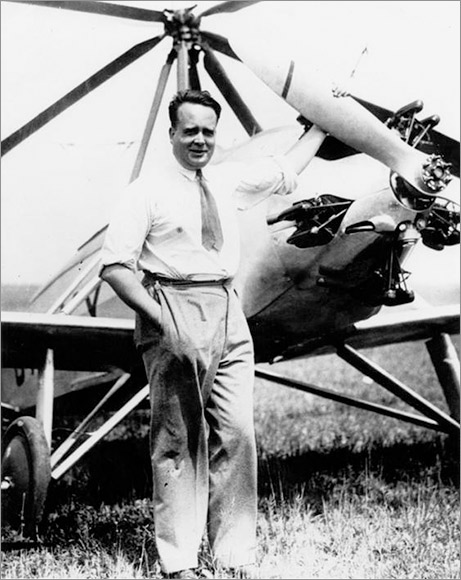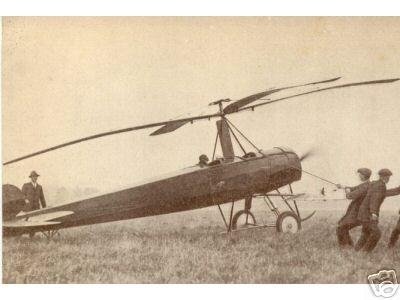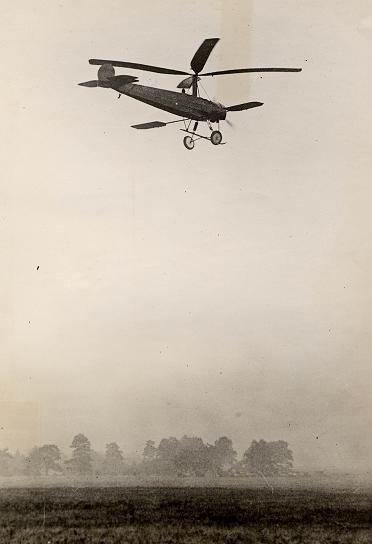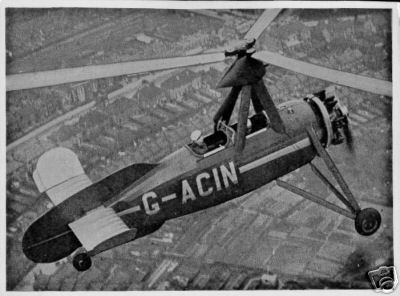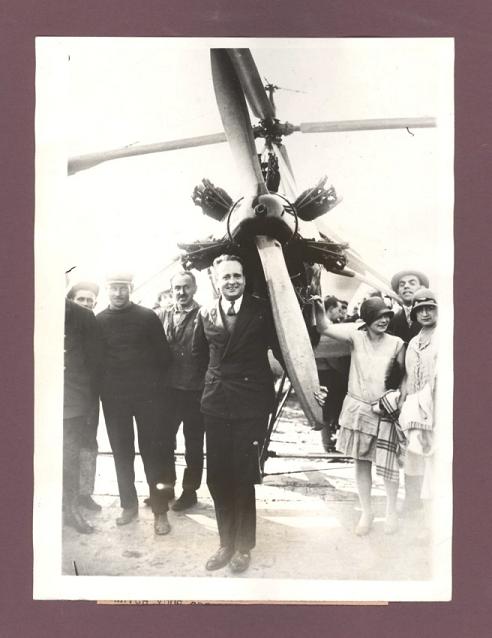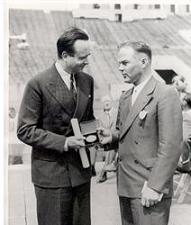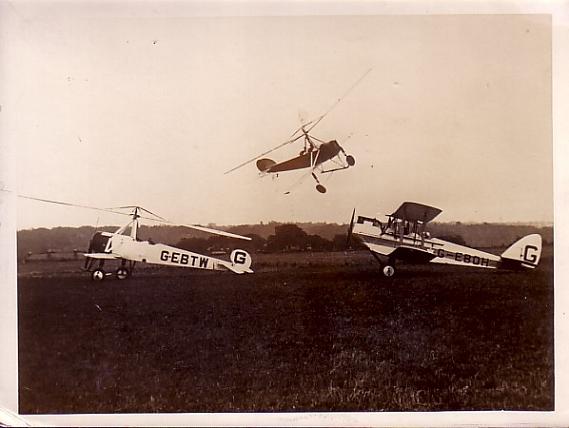|
Juan de la CiervaInventor of the Autogiro
Photograph Provided by Dr. Bruce Charnov, Hofstra University, All Rights Reserved.
Juan de la Cierva was born on September 21, 1895 in Murcia, Spain. Born unto a wealthy family, as a teenager Juan experimented with gliders. His earliest aircraft experiments began as early as 1912. Juan attended the Escuela Especial de Ingenieros de Caminos, Canales y Puertos in Madrid for six years, earning his degree in civil engineering. Cierva, with his education complete, entered a competition to design an aircraft for the Spanish military. His design entry was a bi-wing bomber that was tested in May of 1919. Unfortunately, the pilot stalled the aircraft and crashed. Juan created a tri-motor airplane in 1918 and had successfully completed three flights in the ship and then it too crashed in 1919. Rather than let this string of events deter him from building aircraft he began a search to design an aircraft that would be independent of the stall characteristics found with fixed-wing aircraft. Following serious investigation into overcoming the stall issues on airplanes de la Cierva started an approach at making the wing move continuously in the relative airstream.
Early Autogiro Experiments: His first approach to the problem was to provide a rotational wing and conducted several experiments with rigidly mounted rotors. While these early aircraft had plenty of engineering problems to overcome the basic foundation of his idea was laid and the autogiro was patented in 1920. Juan could see that refinements were needed to absorb the flight loads imposed on the rotor blades and the need to reduce vibration present in the rigid rotors. Most importantly, Cierva realized that the advancing blade was producing more lift than the retreating blade resulting in an aircraft that tended to roll toward the retreating blade side when the aircraft attempted to take off. This was a major finding in controlling the forces acting upon the rotor and the primary reason other inventors had failed to produce a working version of the helicopter. While other experiments of rotary flight tried to power the rotor blades de la Cierva took a more simplified approach in allowing the rotor blades to free-spin or autorotate, with thrust being provided by a propeller. To overcome the lifting tendency of the advancing blade (known as dysemetry or assymetry of lift) Juan decided to hinge the joint at the rotor hub to allow the blades to flap. This would allow the blades to naturally speed up or slow down depending on their position in the rotor disc. He then realized he might have a greater reduction in vibration in he allowed the blades to seek their own lateral position in rotation. Juan incorporated another set of hinges to allow the blades to lead or lag in their position about the mast. The idea not only worked, it worked very well and Cierva could build his rotor blades from strong yet light weight materials that would be needed to get the performance he sought for in his design. With these hinges, at the hub, the rotor blades did not have to absorb all of the stresses imposed on them directly and the rotor design is known as an articulated rotor. The Cierva design articulated rotor was the breakthrough needed for safe rotary flight. After four years of experimentation, Juan de la Cierva developed the articulated rotor which resulted in the world's first successful flight of a stable rotary-wing aircraft the C.4 prototype. Juan’s initial design goals were quite high. He not only wanted to design and build an aircraft which would not stall, he also wanted to develop an aircraft that had short take-off capability and was able to land in small areas. The Cierva autogiro achieved those goals. The fuselage and empennage assembly was of similar design as to those of an airplane, thrust being provided by an engine and propeller. Lift being provided not by fixed wings but by large rotating airfoils known as rotors, mounted horizontally above the craft and rotated by airflow moving up through the rotor disc. Aircraft Leading up to the C.4: 1920: Cierva C.1: A single place, single engine autogiro with tandem rotors mounted on a single common mast. 1921: Cierva C.2: A single place, single engine autogiro with a single rotor. Similar in design to the C.1 with additional surface area to the vertical stabilizer. 1922: Cierva C-3: A single place, single engine autogiro with a single rotor with bracing wires on both the upper and lower surfaces of the rotors.
The world's first practical autogiro flew 200 yards on January 9, 1923 in Madrid, Spain by Lt Gomez Spencer. Two days later the autogiro was unveiled to the public and made three flights, the longest of which was flown over a two and a half mile closed circuit at an average speed of 37 mph (60 km/h). The C.4 was a single place, single four-bladed rotor design. Power came from a 110 hp le Rhone engine. The C.4 was quickly followed with a three bladed design in the single seat, single engine C.5. In 1924 Cierva built his next design as the C.6. In 1925, Juan moved to England, where with the support of Scottish industrialist James G. Weir, he founded the Cierva Autogiro Company. Also, in 1925 he brought his C.6 to England and demonstrated it to the Air Ministry at Farnborough. The C.6 had a four bladed rotor with flapping hinges but relied upon conventional aircraft controls for pitch, roll and yaw. The basic structure came from an Avro 504K fuselage, prerotation of the rotor was achieved by pulling a rope passed around stops on the undersides of the blades by a ground crew. It should be noted that Cierva did not fly these early versions of his aircraft. In further designs of his aircraft Cierva did fly as the pilot. On September 18, 1928, he flew one of his autogiros (C.8) across the English Channel, and in 1930, he flew one from England to Spain. Autogiros were used during the 1930s for military liaison, mail delivery, and agricultural purposes.
Photograph Provided By Dr. Bruce Charnov, Hofstra University, All Rights Reserved.
Photograph Provided By Dr. Bruce Charnov, Hofstra University, All Rights Reserved.
Photograph Provided By Dr. Bruce Charnov, Hofstra University, All Rights Reserved.
Cierva's autogiros gained acceptance within the aviation community and the Cierva Autogiro Company began to sell build rights of Cierva Autogiro’s. It must be noted that the word Autogiro was a tradename of Cierva’s windmilling rotary-wing aircraft. Soon these new companies under license of Cierva began to further develop the design and refine it into a true working aircraft. Among these developments, conducted by Cierva, Pitcairn, Wier, and others was various means to mechanically versus physically prerotating the rotor blades. A very important element of providing direct pitch control to the rotor was also developed. It should be recalled that previous control of the aircraft was accomplished with regular flight control surfaces as utilized in fixed-wing aircraft. The ability to directly tilt the rotor gave the autogiro even more control responsiveness especially at slower aircraft speeds. Further advances in the design lead to “jump take-off” capability and a means to move the mast in flight for added stability.
The preceding features were incorporated over various Cierva models over the years and culminating in the design of one of the most widely recognized autogiro’s in the world the C.30. This aircraft was produced in good numbers for both military and civil use. Varients of this aircraft were built by Focke in Germany and by Kayaba in Japan. Other well-known companies producing Cierva autogiros at the time include but not limited to Westland, Avro, De Havilland, Comper as well as designs being produced in France and Russia. It appeared that the company was doing quite well and that the future of Cierva Autogiro Company would become a force among the aviation industry.
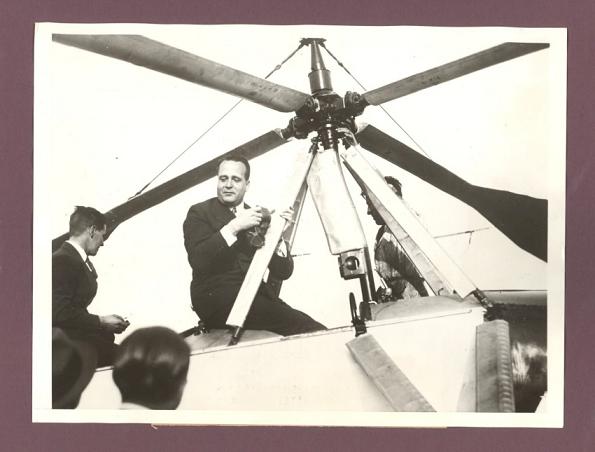
Photograph Provided By Dr. Bruce Charnov, Hofstra University, All Rights Reserved.
At the outbreak of the Spanish Civil War (July 17, 1936 to April 1, 1939) , De la Cierva supported the forces of Francisco Franco, helping the rebels to obtain the De Havilland DH-89 'Dragon Rapide' which flew General Franco from the Canary Islands to Spanish Morocco. His brother was executed by the Republican army in Paracuellos del Jarama.
In a very ironic twist of fate the man who spent the better part of his life to develop a safe aircraft would loose his own life in an aircraft accident. On the morning of 9 December 1936, de la Cierva boarded a Dutch DC-2 of KLM at Croydon Airfield, bound for Amsterdam. After some delay caused by heavy fog, the airliner took off at around 10.30am, during take off it stalled and crashed on the roof of a building at the end of the runway and burst into flame. At the time, it was the single worst aviation accident in British history.
Photograph Provided By Dr. Bruce Charnov, Hofstra University, All Rights Reserved.
The impact of a single manThe importance of Cierva’s work on rotors and the effect upon the evolution of the helicopter cannot be overstated, and is indeed recognised throughout the industry. In the process of creating the Gyroplane (Autogyro), Cierva established an understanding of rotor dynamics and control, which was applicable to all rotorcraft, and undoubtedly led to the realisation of the helicopter. Technology developed for the Autogiro was utilized by experimenters in the development of the helicopter, the first fully successful example of which, the Fw 61, was flown in 1936 by Cierva Autogiro Company licensee Focke-Achgelis. The Autogiro also led directly to the Cierva C.38 Gyrodyne, which utilized a powered rotor for hovering and low speed flight, and a side-mounted propeller for torque correction and propulsion in cruise flight. As airspeed increased, propeller power increased while rotor power automatically decreased which reduced rotor collective pitch to autorotative angle with the rotor remaining parallel to the flightpath. As airspeed reduced, propeller power decreased while rotor power automatically increased which increased rotor collective pitch to non-autorotative angles. The Fairey Gyrodyne, first flown in 1948, established the superiority of this configuration over that of the helicopter, which De la Cierva consistently rejected as too mechanically complicated, even though he agreed with the requirement for hovering performance.
Invested 1966 in the International Aerospace Hall of Fame
Photograph Provided By Dr. Bruce Charnov, Hofstra University, All Rights Reserved.
Photograph Provided By Dr. Bruce Charnov, Hofstra University, All Rights Reserved.
Closing Comments By: Dr. Bruce CharnovDr. Bruce H. Charnov Juan de la Cierva was born in Murcia Juan de la Cierva: A Tribute , Spain on September 21, 1895, and by 1908-9, had decided to make aviation his career. In 1911 he enrolled at the Civil Engineering College of Madrid and in 1912 with his friends “Pepe” Barcala and Pablo Diaz constructed the first Spanish airplane, the BCD-1, known as “El Cangrejo” - the “Red Crab”, becoming the “Father of Spanish Aviation.” In 1919 Cierva produced a large three-engine bomber that, piloted by Captain Julio Ríos Argüeso, stalled and crashed in its initial flight. Pondering the crash, Cierva’s brilliant insight was to see the wing differently --- he reasoned that stall could be effectively eliminated if the wing itself moved independently of the aircraft. The rotor, a moving , stall-proof wing, was placed on top of a fuselage. He patented the name “Autogiro” and it flew by autorotation, “the process of producing lift with freely-rotating aerofoils by means of the aerodynamic forces resulting from an upward flow of air.” As long as the Autogiro was propelled forward, air coming up through the rotor would generate lift. Between 1920 – 23 Cierva progressively developed autorotation in the C.1, C.2 and C.3, but it would be his forth model that would succeed. Cierva stated that the first flight of his C.4 Autogiro was on January 9, 1923 at Getafe airfield outside Madrid when (Calvary) Lieutenant Alejandro Gómez Spencer guided the craft in taxi tests during which the craft became airborne but the first ob-served (and filmed) flight of C.4 took place on January 17, 1923 when Gómez Spencer flew 600 ft at a steady height of 13 ft across the field. This marked he beginning of successful rotary-wing flight. Transferring operations to England in 1925 and forming Cierva Autogiro Ltd on March 24, 1926 with prominent Scottish industrialist James G. Weir, his brother Viscount William Weir of Eastwood and Sir Robert M. Kindersley, Cierva continued to improve the Autogiro and in February 1929 licensed the technology and patent rights to Harold Frederick Pitcairn of Bryn Athyn, PA, thus marking the beginnings of rotary-wing flight in America. The Autogiro generated a great deal of interest. The ‘Father of Naval Aviation’, Rear Admiral W. A. Moffett, who would later perish in the crash of the USS Akron (ZRS-4), stated: “The Navy is very interested in the possibilities of the autogiro. We have ordered one so that experiments may be carried out toward determining its adaptability to naval needs. The ability of the autogiro to land within a limited space its ability to hover over one point should make it extremely useful for reconnaissance work over bad country where adequate landing fields do not exist. There can be no doubt but what the development of the autogiro is the outstanding achievement in aviation during the past year.” And pioneering (and controversial) Army Air Corps aviator ‘Billy’ Mitchell stated: “A very interesting type of heavier-than-air craft is the Cierva autogyro. It is neither a helicopter nor an airplane. It consists of a body or fuselage very similar to that of an airplane. In its nose there is a motor and an ordinary type or propeller. Its small stubby wings and tail surfaces are somewhat similar to that of any airplane. The remarkable feature of this machine is the windmill, or rotary wing which is mounted over it. This windmill, or rotor as it is called, is not actuated directly by any power from the engine but is made to revolve by the airstream from the propellor striking against it. When an ordinary airplane takes off in flight, its propeller gives it speed through the air and makes air pass under the wing at such a rapid rate that the airplane rises. With the autogyro, instead of the wing being fixed in position, it rotates and goes through as many particles of air in a given time a the wing of an airplane does; but with the windmill, instead of a great deal of forward motion being required, it is accomplished in one place by rotation. . . . The machine can be made to hover over a certain place when climbing it upward. It can be brought straight down to the ground and landed on a place without any forward motion. . . . The autogyro has been very successful in its flights and promises a great deal for the future, where machines are required to land on the top of a building, a small field, in a forest or the top of a mountain.”
After Juan de la Cierva’s tragic death in the crash of a KLM DC2 at Croydon Airfield on December 9, 1936, many who had known him rendered tributes to his vision. “It appears fitting, when we meet to discuss one or the other of many aspects of rotary wing flight, that we should direct our thoughts to the one man (alas no long with us) whose creative ability and genius not only made possible the Autogiro; but whose foresight and tenacity of purpose so well and truly laid the foundations upon which the helicopter now so surely stands” Wing Commander R. A. C. Brie “Some Problems of Helicopter Operation and Their Influence on Design” The Journal of the Helicopter Association of Great Britian: 1947 “One of his great charms was his modesty. He never promised more than he could fulfill and he was that very unusual type of inventor: the man who knew more about the theory and practice than anyone else. He had the courage of his convictions and learned to fly his own machines, not merely tolerably, but extremely well. No better way of honouring his memory could be imagined than to carry to its ultimate solution the great work which he started.” Flight in tribute to Juan de la Cierva after his death on December 9, 1936 as quoted in John Fay’s book The Helicopter “Juan de la Cierva will be known to enduring fame as the outstanding pioneer in the field of rotary wing aircraft . . . .All helicopters and similar types of craft that have shown promise of practical performance incorporate some of the principles and inventions developed by Cierva.” Harold F. Pitcairn ”Juan de la Cierva: In Memoriam.” Autogiro Co. of America January 9, 1939
Cierva – Personal Reflections If one wishes to get a sense of Cierva, two of the best personal recollections are found in P. T . Capon’s articles: “Capon’s Corner – Cierva Autogiros” Aeroplane Monthly. Vol. 11 No. 7 Issue 123 July 1983 pp. 354 – 356; “Cierva’s First Autogiros – Part 1” Aeroplane Monthly. Vol. 7 No. 4 April 1979 pp. 200 – 205 “Cierva’s First Autogiros – Part 2” Aeroplane Monthly. Vol. 7 No. 4 May 1979 pp. 234 – 240 (“We used to call him John . . . “) and in Frank Courtney’s Flight Path. London: William Kimber 1972. Also published as The Eighth Sea. New York: Doubleday & Co., 1972, particularly the account of the a chance meeting and dinner in London the night before Cierva died. Cierva was both a pioneer and a genius – the memory and celebration of him as the “Father of Spanish Aviation” seems due much more to happenstance than to intention, but there can be no doubt that his enduring fame and reputation justifiably flows from his rotary-wing achievements. While others had approached the topic, with limited success, Cierva was the first to achieve practical rotary-wing flight. This was founded upon a unique sight – hindsight, insight and foresight. His exploration was grounded in theory where his mathematical abilities served him well; and his papers, presentations and books can still be read today with advantage and continuing value. While it may be true that Cierva eventually came to be seen by American Harold Pitcairn as a rival, and some have suggested that Cierva had come to see the American rotary-wing industry as a ‘proving ground’ for his aircraft improvements, it is equally obvious that Cierva’s insight, enthusiasm and vision saw the development of the conceptual basis and, to perhaps an equal extent, the mechanical foundation of the practical helicopter. Cierva, as Pitcairn, mightily resisted mechanical complexity and saw in the Autogiro a rotary-wing solution that offered the greatest advantage with lesser complications . . . and yet, before his death his company had licensed his technology to German’s H. K. J. Focke, which would lead to the Fa-61, and Austria’s Raoul Hafner was already developing the ‘spider system’ in the 1935 A.R. III gyroplane in England that would allow the Autogiro to morph into the helicopter. Cierva was certainly aware of these developments and, albeit it slowly, was moving in the direction of helicopter development as were significant personnel in his company. But his genius and enduring reputation will forever rest with the creation of the Autogiro. But perhaps FORTUNE Magazine best summed up Cierva’s contribution in 1936, when it stated: “[The Autogiro was] the only basic contribution to the art of flight since the Wright brothers rode a biplane into the air in 1903.” Where and whenever the pioneers of aviation are celebrated, Juan de la Cierva’s name is enshrined. He is one of the few in history of whom it can be said that what he and envisioned changed the world.
General William “Billy” Mitchell, Skyways 1930 Fay, John. The Helicopter. New York: Hippocrene Books, 4th ed., 1987 p. 139 “Autogiro in 1936.” Fortune Vol. XIII No. 3 March 1936 88 – 93, 130 – 131, 134, 137: 88 Material Reference to Juan De La Cierva: 1. Cierva, Juan de la, and Don Rose. Wings of Tomorrow: The Story of the Autogiro. New York: Brewer, Warren & Putnam 1931 (also found in a condensed version in Readers Digest. Vol. 18 No. 108 April 1931 pp. 1079 *1081) See also J. Gordon Leishman’s superb series of historical articles: “The Autogiro: The First Rotating-Wing Aircraft * Part 4” Vertiflite Vol. 51 No. 3 Fall 2005 pp. 58 - 61 “The Autogiro: The First Rotating-Wing Aircraft * Part 3 * Scorpion Tails and Jumping Takoffs” VertifliteE. Vol. 49 No. 4 Winter 2003 pp. 36 * 39; “The Autogiro: The First Rotating-Wing Aircraft * Part 2 * Capsizing Rotors and Flapping Blades” Vertiflite. Vol. 49 No. 3 Fall 2003 pp. 46 * 49; “The Autogiro: The First Rotating-Wing Aircraft * Part 1 * That Curious Phenomenon of Autorotation” Vertiflite. Vol. 49 No. 2 Summer 2003 pp. 46 * 48 2. Sanders, C. J. and A. H. Rawson. The Book of the C.19 Autogiro. London: Sir Isaac Pitman & Sons, 1931 3. Brie, R.A.C. The Autogiro and How to Fly It. London: Sir Isaac Pitman & Sons, 1933 2d. ed. 1934 4. Cierva, Juan de la ”The Autogiro.” Journal of Royal Aeronautical Society, London: The Royal Aeronautical Society, Lewis Press Vol. XXXIV No. 239 November 1930 pp. 902 * 921 (AUTOGIRO) 5. Brooks, Peter W. Cierva's Autogiros: The Development of Rotary-Wing Flight. Washington, D. C.: Smithsonian Institution Press, 1988) (AUTOGIRO) This is the most comprehensive account of the Autogiro and indispensable reading * if you had only one book to read, this is it. Contains comprehensive listing by registration number of all the Autogiros produced with good accounts of England, America, Germany, France, Japan and Russia with abbreviated references to the Fairey Rotodyne and the autogyros of Wing Commander Ken Wallis. Generally available at ABEBOOKS.com, occasionally on line and in a fair number of libraries.
See also Capon, P. T. “Cierva’s First Autogiros * Part 1” Aeroplane Monthly Vol. 7 No. 4 April 1979 pp. 200 * 205; Capon, P. T.“Cierva’s First Autogiros * Part 2” Aeroplane Monthly Vol. 7 No. 4 May 1979 pp. 234 * 240; Capon, P. T. “Capon’s Corner * Cierva Autogiros” Aeroplane Monthly. Vol. 11 No. 7 Issue 123 July 1983 pp. 354 * 356; Brooks, Peter W. “Rotary Wing Pioneer.” Aeroplane December 9 and 16, 1955. See also the following very significant and informative Fortune Magazine articles that are rich in text and photographs, and which come up often on line at auction: Ingalls, David S. “Autogiros * Missing Link” Fortune. March 1931 pp. 77 * 83, 103 * 104, 106, 108, 110; “Autogiros of 1931 - 1932” Fortune March 1932 pp. 48 * 52; “Autogiro in 1936.” Fortune Vol. XIII No. 3 March 1936 88 * 93, 130 * 131, 134, 137. And of interest; Hiett, T. R. “Cierva’s Rotating Wings” AirEnthusiast. Issue 106 July/August 2003 pp. 26 * 31; Fernandez, José “Les Autogires La Cierva et LeO C-30” (French) AirMagazine. July No. 3 pp. 19 * 43; Hunter-Jones, Georgina “The Cinderella of the Sky” HelicopterLife. Autumn 2004 pp. 28 * 38; “The Autogiro: Newcomer in the Skies” printed in The Aircraft Year Book For 1932 Vol. 14 pp. 415 * 428 (Compiled, Written and Edited by Aeronautical Chamber of Commerce of America, Inc.) New York: D. Van Nostrand Company, Inc. 1932
Site Comments:Certainly an entire website could be devoted to aviation pioneer Juan de la Cierva. His buisiness skill, engineer genius, piloting skill and devotion to flight safety are all topics which can be much further commented upon than the confines of this site. Juan not only invented a product to bring to market but continued to improve upon his design to provide greater performance and handling. With Cierva came the life of the autogiro and with his death also the beginning of the end of the autogiro for after only a few short years the autogiro fell from public eye as helicopters began to rule the realm of vertical flight. Fortunately, Raul Hafner's (Cierva Liscensee) Rotachute would inspire Igor Bensen to design the new form of autogiro into the modern gyroplane. Funny how we must go back to our roots to further progress our advancement in aviation, much like Burt Rutan with his canard design, today we stand on the brink of new machines and technology that was being investigated back in the time of Cierva. Today, 2008, there is the Piaseki test aircraft that is a modern version of the goals of which Cierva was striving for in his rotorcraft designs. Sikorsky is also investigating the benefits of autorotational flight with their new research aircraft. As well as Jay Carter Jr. with his slowed rotor concept. All ideas that were being evolved by the Cierva Company back in the late 1930's. These new designs are showing promise of speeds near that of regional. commuter, speeds and opens a whole new door for vertical flight. It is doubtful the helicopter will disappear but the new designs may offer greater speed, range and economy over a variety of uses and operate at a much lower expense. Cierva still continues to inspire and awe us today with his aeronautical genius. I personally owe a great debt of thanks to Bruce Charnov for his valuable contribution to this tribute. Dr. Charnov's great insight in the life of Cierva and also for providing the photographs used on this page. A leading authority on autogiro history and development. It has been both an honor and pleasure to work with this fine individual. Thank you Bruce for your involvement in a fitting tribute to the founder of our industry.
Picture Gallery link to the Hofstra University:
http://en.wikipedia.org/wiki/Juan_de_la_Cierva http://www.centennialofflight.gov/essay/Dictionary/cierva/DI17.htm http://www.encyclopedia.com/doc/1E1-Cierva-J.html http://www.allstar.fiu.edu/AERO/cierva.htm Gyroplane Video: A copy may be ordered by sending a check for $19.95 + $3.50 shipping & handling to: Bruce Charnov 134 Hofstra University Hempstead, NY 11549
www.hofstra.edu/autogiro-conference www.greenwood.com - search terms From Autogiro to Gyroplane. |
